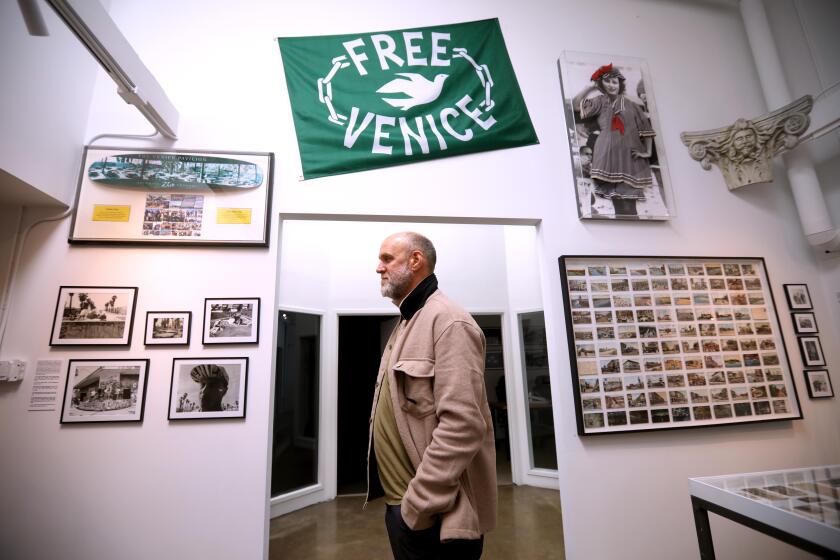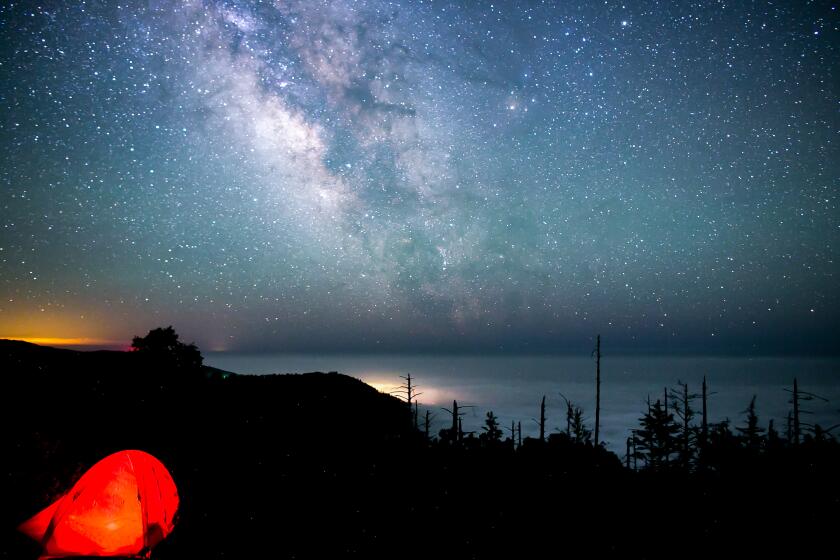Storm Helps Dissipate Oil; New Slick Is Investigated
Rushing rainwater Saturday wiped out earthen dams protecting fragile wetlands from the oil spill and hampered cleaning crews along Orange County’s coast, but environmentalists said the storm might help scrub the shore of contamination.
However, the Coast Guard reported seeing a new and different-looking sheen of oil on Bolsa Chica State Beach in Huntington Beach on Saturday, raising suspicions that there was a new source of leakage. Samples of the oil were promptly sent to the Coast Guard Oil Identification Laboratory in Groton, Conn., for testing to determine whether the oil matched the crude spilled 11 days ago by a tanker mooring off Huntington Beach.
Because the oil spilled from the tanker, the American Trader, had been drifting southward, officials were concerned to see the sheen on the north end of Huntington Beach.
Coast Guard Petty Officer Elizabeth Neely said the sheen was spotted from the air on Coast Guard flights over the spill area throughout the day, and later, officials and workers on the ground also noticed it.
“The consistency of this oil doesn’t look the same and . . . the rest of the oil (from the tanker) seems to have drifted in a southerly direction. So to see this--we just wanted to make sure it was the same oil from the same place,” she said. “It raised enough suspicion that someone thought they should take a sample to see if it was from the same spill.”
She said test results--”like a fingerprinting test that you do on oil”--probably would not come back for at least three to five days.
Saturday’s violent winds and the cold, piercing rain played havoc with cleanup efforts, pushing a protective containment boom out to sea and sending workers in yellow slickers scurrying for cover.
The storm, which dumped about two inches of rain in the area and was expected to continue through the weekend, washed away three temporary earthen dams that had been keeping oil-contaminated water from wetlands near the mouth of the Santa Ana River. And skimmers working off the coast to scoop up the remaining oil in the ocean halted their efforts because of the choppy sea, the Coast Guard said.
But while the weather made work more uncomfortable, officials said it did not reverse progress already made on getting the oil off the beaches and out of the ocean.
A boom protecting Newport Harbor, blown away by the storm, was not replaced when officials determined a second boom--which withstood the winds--was sufficient.
Saturday’s nonstop rain also dampened one demonstration against offshore oil drilling by several environmental groups and forced organizers of another demonstration to cancel.
Greenpeace’s Los Angeles chapter had scheduled a demonstration at Laguna Beach’s Main Beach at noon, but nobody came. The only people present were the 15 organizers, armed with 400 placards that said “Ocean Protection Now,” a public address system and a portable generator.
Ed Bierling, assistant coordinator for the organization, said he almost canceled the demonstration. But he added: “We’re committed activists. . . . The weather doesn’t matter.”
The Feb. 7 spill, which occurred when the tanker’s anchor pierced the ship’s hull, dumped 394,000 gallons of oil into the water. It has been washing ashore on nearly 20 miles of Orange County’s coastline, and area beaches remain closed.
At the mouth of the Santa Ana River on Saturday, environmentalists and flood-control officials watched as the downpour washed away one dam at a time that had been constructed to protect three channels from oil-tainted water.
For more than a week, they had weighed the consequences of damming up the channels, because while the dams would keep contaminated water from flowing into sensitive, newly restored marshlands, they could also cause flooding in a storm if waters from the swollen river and channels were not allowed to flow out during heavy rain.
On Saturday, as the raging waters of the river rushed out to sea, taking debris, parts of the dam and even some oil that had leaked in back out into the ocean, environmentalists said they thought the dams had done their job of protecting the wetlands.
“There was a lot of crude oil retained here and now that has washed out to sea,” said Gordon Smith, director of the Huntington Beach Wetlands Conservancy. “Hopefully, there isn’t any more oil out at sea that will come back.
“This is good for us. It will flush everything out,” he said. “Things turned out just the way we hoped they would.”
On Friday, some of the last remnants of oil from the offshore spill washed into tide-pool areas just north of Laguna Beach.
At Crystal Cove State Beach near Laguna Beach, where residue from a transparent slick--which apparently broke off from the main spill--had washed ashore, about 20 workers sat in a van at the edge of the water Saturday, taking turns stepping gingerly out to pick up oil-covered debris or seaweed.
“It’s basically cleaned up now,” said Wayne Davis, a supervisor from Martech, one of the contractors that provided workers for the cleanup. “We’ve got a little bit left, but nothing major.”
He said mostly foamy brown residue was washing up on the beach, but the wind and the rain were making work difficult.
Sam Sacco, a spokesman for British Petroleum, owner of the oil aboard the tanker, said cleanup is in the last stages. Only 470 workers were patrolling the beaches Saturday, down from 635 Friday. Of those, 200 were working north of the Santa Ana River, mostly near the Huntington Beach Pier, with 270 others between the Santa Ana River and Laguna Beach, including 40 south of Newport Beach’s Balboa Pier.
“You’re not going to see 1,400 people on the beach any more. You’ll see crews along the lines of 300 to 400,” Sacco said.
“We’re continuing with the same procedure as yesterday, raking oil off the top of the sand--fine-tune cleaning,” he said. “It’s a slower process, more meticulous, but it’s got to be done.”
He said 150 workers will be posted on the beaches overnight Saturday, but that by Monday, the evening shift will be eliminated.
“The kind of work we’re doing now is not very effective at night,” he said.
On Saturday, the number of live birds found covered with oil had increased to 410. Another 275 were dead, according to Lt. Tim Sawyer of the state Department of Fish and Game.
Officials at the bird rescue center in Huntington Beach announced that instead of training more volunteers to walk the beaches looking for birds, they have set up a 24-hour hot line--(714) 536-0202--for people to call if they find an oil-covered bird. Center workers will then pick the birds up.
Meanwhile, in Long Beach, Coast Guard and American Bureau of Shipping officials were inspecting the docked American Trader to determine what additional work must be done before it can be moved to a shipyard for permanent repairs, officials said.
Before it returned to the harbor Monday, the tanker received a temporary patch of metal and wood over two holes in its hull, apparently caused by its own anchor, but a cement patch is to be attached during the next few days.
The spill occurred when the tanker was attempting to enter a mooring off Huntington Beach to unload its cargo into an underwater pipeline less than two miles from the shore.
Coast Guard officials investigating the accident are banning tankers from the mooring area until the investigation is completed. Preliminary indications show water beneath the 810,000-ton tanker may have been shallower than its crew believed.
Also on Saturday, Gov. George Deukmejian, under fire by local officials for not declaring the area a state of emergency, praised the state’s quick response in cleaning up the spill.
In a radio address, the governor promised a thorough investigation into the cause of the accident and reiterated his support for offshore drilling.
Staff writers Chris Woodyard, Shelby Grad, Tom McQueeney and Greg Hernandez contributed to this story.
More to Read
Start your day right
Sign up for Essential California for news, features and recommendations from the L.A. Times and beyond in your inbox six days a week.
You may occasionally receive promotional content from the Los Angeles Times.






